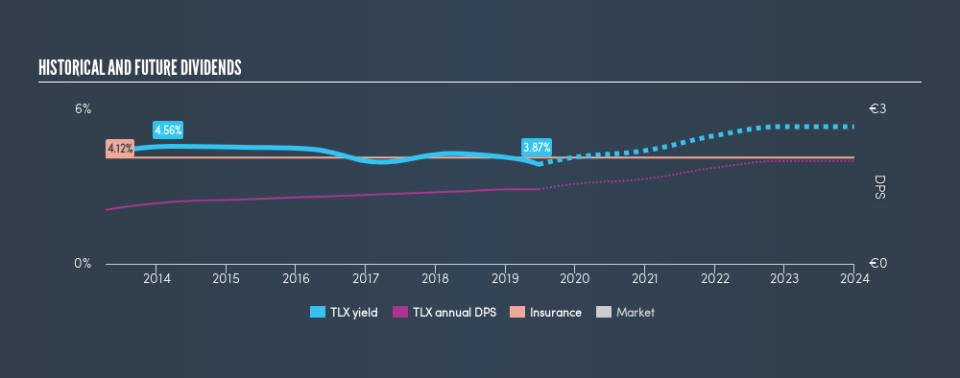Do Investors Have Good Reason To Be Wary Of Talanx AG's (ETR:TLX) 3.9% Dividend Yield?

Want to participate in a short research study? Help shape the future of investing tools and you could win a $250 gift card!
Could Talanx AG (ETR:TLX) be an attractive dividend share to own for the long haul? Investors are often drawn to strong companies with the idea of reinvesting the dividends. If you are hoping to live on the income from dividends, it's important to be a lot more stringent with your investments than the average punter.
With a six-year payment history and a 3.9% yield, many investors probably find Talanx intriguing. We'd agree the yield does look enticing. Some simple research can reduce the risk of buying Talanx for its dividend - read on to learn more.
Explore this interactive chart for our latest analysis on Talanx!
Payout ratios
Dividends are usually paid out of company earnings. If a company is paying more than it earns, then the dividend might become unsustainable - hardly an ideal situation. As a result, we should always investigate whether a company can afford its dividend, measured as a percentage of a company's net income after tax. In the last year, Talanx paid out 51% of its profit as dividends. This is a fairly normal payout ratio among most businesses. It allows a higher dividend to be paid to shareholders, but does limit the capital retained in the business - which could be good or bad.
Consider getting our latest analysis on Talanx's financial position here.
Dividend Volatility
From the perspective of an income investor who wants to earn dividends for many years, there is not much point buying a stock if its dividend is regularly cut or is not reliable. Looking at the data, we can see that Talanx has been paying a dividend for the past six years. Its dividend has not fluctuated much that time, which we like, but we're conscious that the company might not yet have a track record of maintaining dividends in all economic conditions. During the past six-year period, the first annual payment was €1.05 in 2013, compared to €1.45 last year. Dividends per share have grown at approximately 5.5% per year over this time.
Talanx has been growing its dividend at a decent rate, and the payments have been stable despite the short payment history. This is a positive start.
Dividend Growth Potential
The other half of the dividend investing equation is evaluating whether earnings per share (EPS) are growing. Growing EPS can help maintain or increase the purchasing power of the dividend over the long run. Talanx's EPS are effectively flat over the past five years. Flat earnings per share are acceptable for a time, but over the long term, the purchasing power of the company's dividends could be eroded by inflation.
Conclusion
To summarise, shareholders should always check that Talanx's dividends are affordable, that its dividend payments are relatively stable, and that it has decent prospects for growing its earnings and dividend. First, we think Talanx has an acceptable payout ratio. Second, earnings per share have been in decline, and the dividend history is shorter than we'd like. With this information in mind, we think Talanx may not be an ideal dividend stock.
Given that earnings are not growing, the dividend does not look nearly so attractive. Businesses can change though, and we think it would make sense to see what analysts are forecasting for the company.
If you are a dividend investor, you might also want to look at our curated list of dividend stocks yielding above 3%.
We aim to bring you long-term focused research analysis driven by fundamental data. Note that our analysis may not factor in the latest price-sensitive company announcements or qualitative material.
If you spot an error that warrants correction, please contact the editor at editorial-team@simplywallst.com. This article by Simply Wall St is general in nature. It does not constitute a recommendation to buy or sell any stock, and does not take account of your objectives, or your financial situation. Simply Wall St has no position in the stocks mentioned. Thank you for reading.


